人教版(2019)必修第一册Welcome Unit Discovering Useful Structures 课件(共23张PPT)
文档属性
| 名称 | 人教版(2019)必修第一册Welcome Unit Discovering Useful Structures 课件(共23张PPT) | 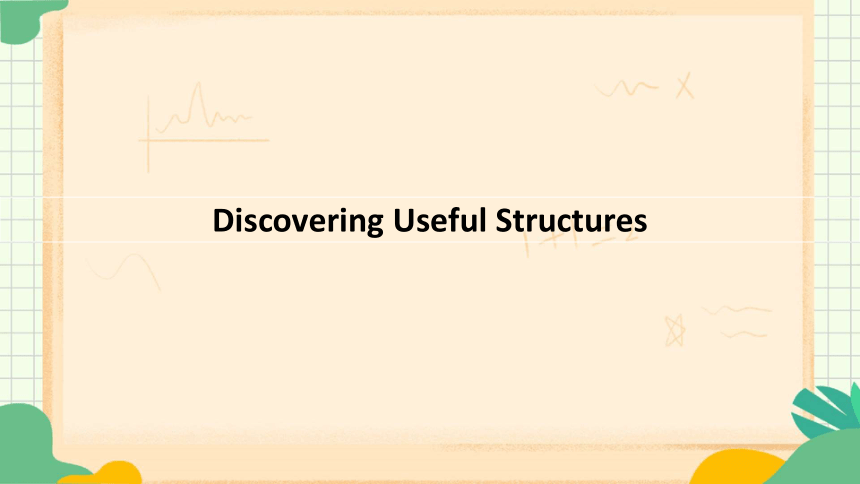 | |
| 格式 | pptx | ||
| 文件大小 | 1.1MB | ||
| 资源类型 | 教案 | ||
| 版本资源 | 人教版(2019) | ||
| 科目 | 英语 | ||
| 更新时间 | 2024-10-08 10:31:18 | ||
图片预览

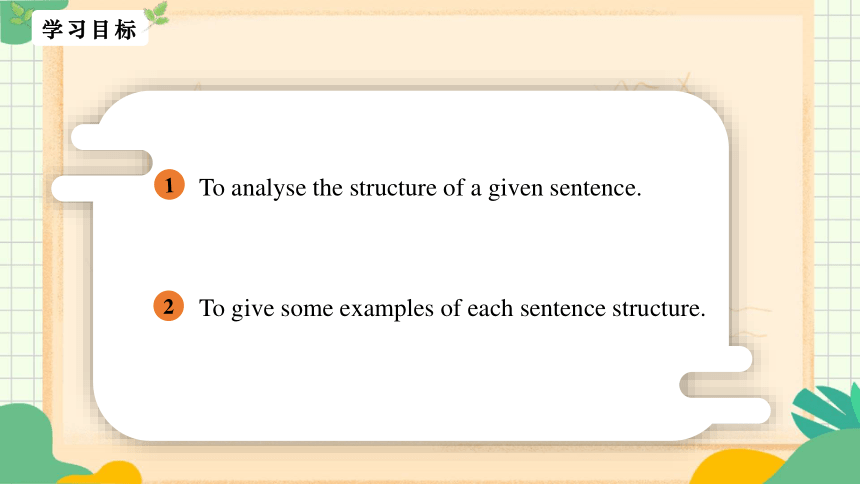
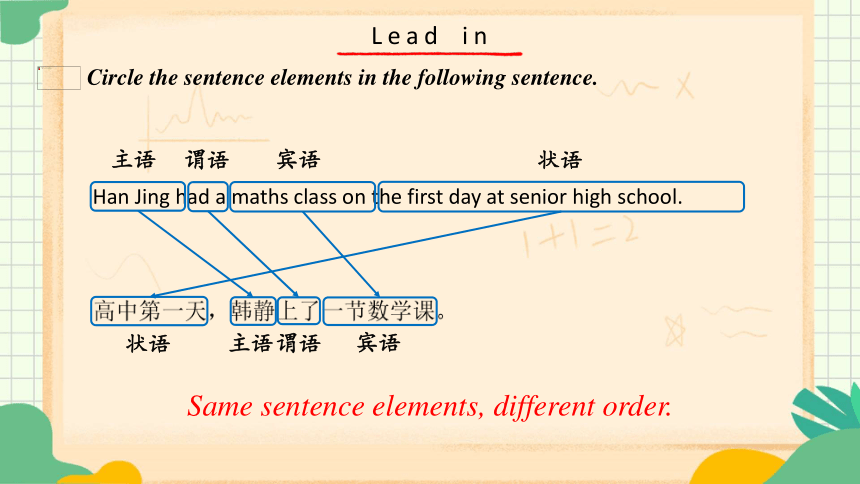
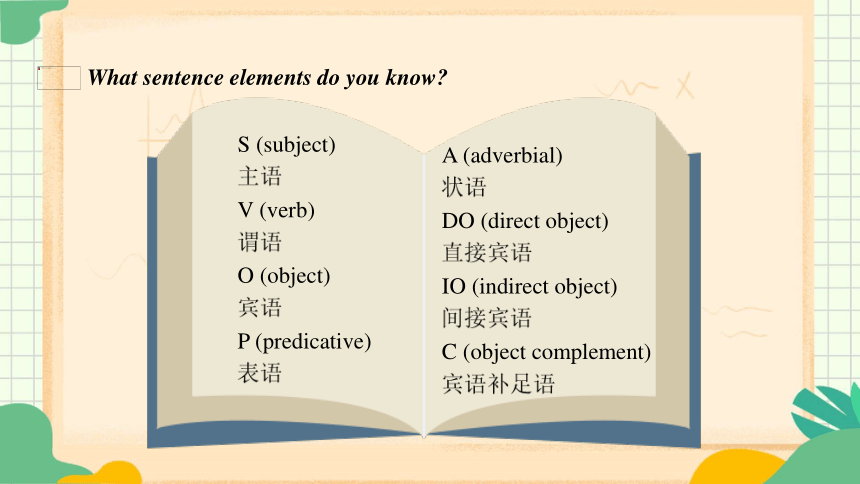
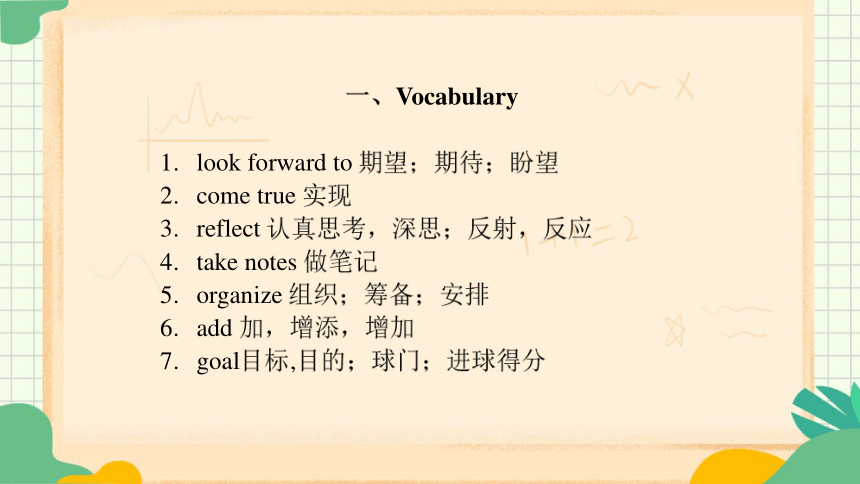
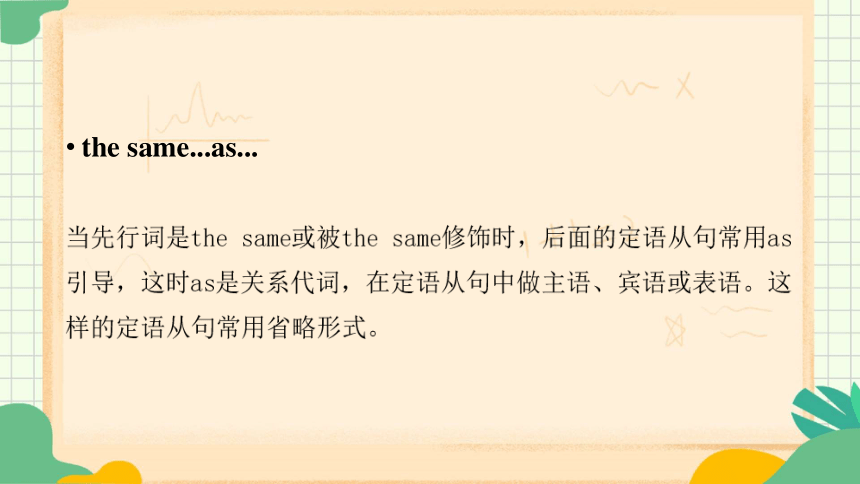
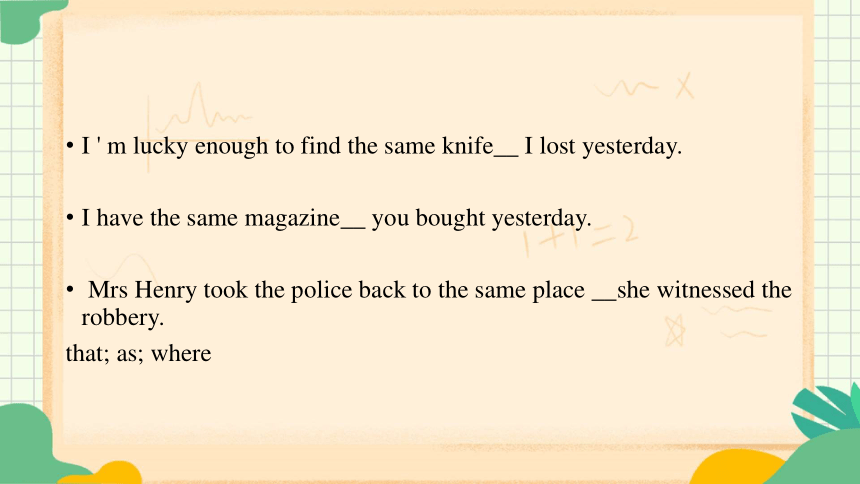
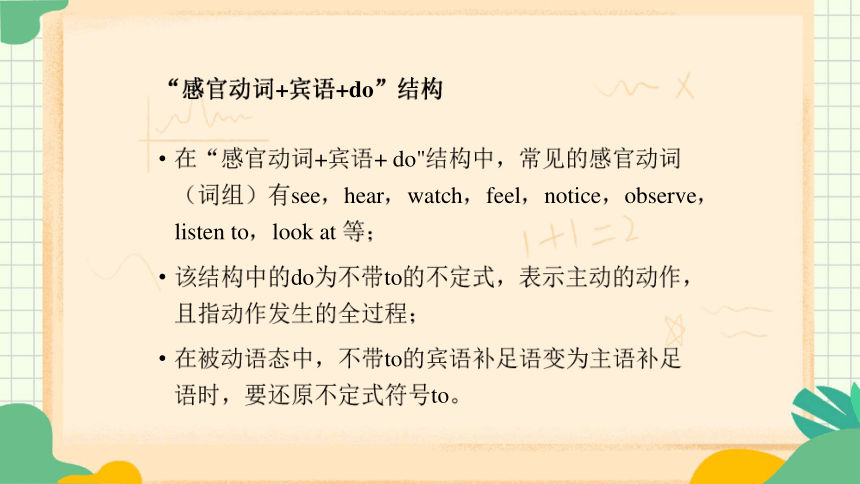

文档简介
(共23张PPT)
Discovering Useful Structures
1
2
To analyse the structure of a given sentence.
To give some examples of each sentence structure.
高中第一天,韩静上了一节数学课。
Lead in
Han Jing had a maths class on the first day at senior high school.
Circle the sentence elements in the following sentence.
主语
谓语
宾语
状语
主语
谓语
宾语
状语
Same sentence elements, different order.
What sentence elements do you know
S (subject)
主语
V (verb)
谓语
O (object)
宾语
P (predicative)
表语
A (adverbial)
状语
DO (direct object)
直接宾语
IO (indirect object)
间接宾语
C (object complement)
宾语补足语
一、Vocabulary
look forward to 期望;期待;盼望
come true 实现
reflect 认真思考,深思;反射,反应
take notes 做笔记
organize 组织;筹备;安排
add 加,增添,增加
goal目标,目的;球门;进球得分
the same...as...
当先行词是the same或被the same修饰时,后面的定语从句常用as引导,这时as是关系代词,在定语从句中做主语、宾语或表语。这样的定语从句常用省略形式。
I ' m lucky enough to find the same knife__ I lost yesterday.
I have the same magazine__ you bought yesterday.
Mrs Henry took the police back to the same place __she witnessed the robbery.
that; as; where
“感官动词+宾语+do”结构
在“感官动词+宾语+ do"结构中,常见的感官动词(词组)有see,hear,watch,feel,notice,observe,listen to,look at 等;
该结构中的do为不带to的不定式,表示主动的动作,且指动作发生的全过程;
在被动语态中,不带to的宾语补足语变为主语补足语时,要还原不定式符号to。
Yesterday,Jack and I were walking down the street when we saw an old man___(fall)off his bike.
I looked up and noticed a snake___(wind)its way up the tree to catch its breakfast.
The students were seen___(play)basketball yesterday aftermoon.
fall; winding; to play
二、What sentence elements do you know
S (subject)
主语
V (verb)
谓语
O (object)
宾语
P (predicative)
表语
A (adverbial)
状语
DO (direct object)
直接宾语
IO (indirect object)
间接宾语
C (object complement)
宾语补足语
是句子的主体,是说明的对象。通常由名词或名词短语、代词 以及v-ing等充当。 说明主语所做的动作或具有的特征和状态,有完整的时态和语
态,一般在主语之后,由动词构成。
表示动作的对象或行为的承受者,一般位于及物动词和介词后 面 (动宾&介宾),一般由名词、代词、数词、动词不定式(短 语)、动名词(短语)等充当。 位于系动词后,用来说明主语的特点,表明主语的性质特征。 一般是副词或介词短语,用来说明动作的程度、地点或时间等。 起修饰、限定名词或代词的作用,分前置定语和后置定语。一 般由形容词、名词、形容词性物主代词、数词、介词短语、动 词不定式(短语)、分词(短语)或从句充当。
宾语补足语 位于宾语之后,对宾语进行补充说明,使句子的意义完整。
主语
谓语
宾语
表语 状语 定语
Study the sentence structures.
主语+谓语 SV
All of us laughed! He is playing.
He will come.
谓语是主语所做的动作。
主语+表语 SP
The teacher was kind and friendly. She is beautiful.
He is a doctor.
表语是对主语特征的描述。
Study the sentence structures.
主语+谓语 SV
All of us laughed! He is playing.
He will come.
谓语一般是不及物动词。
主语+谓语+宾语 SVO
I miss my grandma. She is learning French. He enjoys reading.
谓语必须是及物动词。
Study the sentence structures.
主语+谓语+间接宾语+直接宾语
S V IO DO
He told us a funny story.
I bought my father a present.
She showed her students the technique.
直接宾语和间接宾语一般都是 名词或代词。
主语+谓语+宾语+宾语补足语
SVOC
I found most of my classmates and teachers friendly and helpful.
They named their cat Huahua. (转下页)
宾语补足语与其前面的宾语有逻 辑上的主谓关系,可以是形容词、 名词、介词短语、副词、动词不 定式、现在分词、过去分词。
Study the sentence structures.
(接上页)
SVOC
I found most of my classmates and teachers friendly and helpful. (形容词) They named their cat Huahua. (名词)
She always keeps everything in good order. (介词短语) He found his teacher out when he called on him. (副词)
My mother wants me to take a break from my work. (动词不定式)
I suddenly found someone running down the street. (现在分词) We saw the road covered with snow. (过去分词)
Study the sentence structures.
经常接双宾语的动词有:give, show, bring, pass, lend, tell, teach, write, buy, sing等。
e.g.
Give your mother the letter.
The hospital agreed to lend us a wheelchair.
She is teaching us sign language.
经常接复合宾语(即宾语+宾语补足语)的动词有:let, see, watch, hear, help, feel, call, make, find, tell, ask等。
e.g.
Don’t let her upset you.
She watched the kids playing in the yard.
My mother made me wash the dishes after dinner.
Study the sentence structures.
主语+谓语+状语 SVA
He talked too much.
All students worked very hard. It rains heavily.
主语+谓语+宾语+状语 SVOA
I had my first maths class at senior high school.
I go to the cinema every weekend. He loves his new bike a lot.
谓语是及物动词。
谓语是不及物动词。
Study the sentence structures.
状语有时间状语、地点状语、原因状语、目的状语、结果状语、条件状语、 方式状语和让步状语。
e.g.
I study hard at school every day to get good grades.
(方式状语) (地点状语) (时间状语) (目的状语)
He was late because he got up late. (原因状语) Bend the wire so that it forms a “V”. (结果状语) I go to school by bike. (方式状语)
If you try your best, you will succeed. (条件状语)
Although he is two years old, he can dress himself. (让步状语)
Study the sentence structures.
There be 句型
There’s a lot to explore at senior high. There are two people waiting outside. There must be easier ways of doing this.
意思是“有”,表示“人或事物 的存在”或“某地有某物”。
注意主谓一致,遵循“就近 原则”。
Read the passage and analyze the structures of the underlined sentences.
How would you like to go to school and travel the world at the same time For Tim, that dream has come true! This term, Tim and his classmates are living on a ship! They take the same subjects as you do, like maths and English. They also learn about ships and the sea. Tim writes his parents an email every week and tells them what happened on the ship. Tim loves living on the ship. There's always something exciting to do. And, after a long day of study, he likes to watch the sun go down and wait for the stars to come out. Studying and doing homework seem much more fun when you are at sea!
三、Group work
1. that dream has come true!
2. Tim and his classmates are living on a ship!
3. They also learn about ships and the sea.
S V
S V A
S V O
4. Tim writes his parents an email every week and
tells them what happened on the ship.
5. There's always something exciting to do.
6. Studying and doing homework seem much more fun.
S V IO DO
S P
V IO DO
There be…
How many sentence structures are there
What are they
Discovering Useful Structures
1
2
To analyse the structure of a given sentence.
To give some examples of each sentence structure.
高中第一天,韩静上了一节数学课。
Lead in
Han Jing had a maths class on the first day at senior high school.
Circle the sentence elements in the following sentence.
主语
谓语
宾语
状语
主语
谓语
宾语
状语
Same sentence elements, different order.
What sentence elements do you know
S (subject)
主语
V (verb)
谓语
O (object)
宾语
P (predicative)
表语
A (adverbial)
状语
DO (direct object)
直接宾语
IO (indirect object)
间接宾语
C (object complement)
宾语补足语
一、Vocabulary
look forward to 期望;期待;盼望
come true 实现
reflect 认真思考,深思;反射,反应
take notes 做笔记
organize 组织;筹备;安排
add 加,增添,增加
goal目标,目的;球门;进球得分
the same...as...
当先行词是the same或被the same修饰时,后面的定语从句常用as引导,这时as是关系代词,在定语从句中做主语、宾语或表语。这样的定语从句常用省略形式。
I ' m lucky enough to find the same knife__ I lost yesterday.
I have the same magazine__ you bought yesterday.
Mrs Henry took the police back to the same place __she witnessed the robbery.
that; as; where
“感官动词+宾语+do”结构
在“感官动词+宾语+ do"结构中,常见的感官动词(词组)有see,hear,watch,feel,notice,observe,listen to,look at 等;
该结构中的do为不带to的不定式,表示主动的动作,且指动作发生的全过程;
在被动语态中,不带to的宾语补足语变为主语补足语时,要还原不定式符号to。
Yesterday,Jack and I were walking down the street when we saw an old man___(fall)off his bike.
I looked up and noticed a snake___(wind)its way up the tree to catch its breakfast.
The students were seen___(play)basketball yesterday aftermoon.
fall; winding; to play
二、What sentence elements do you know
S (subject)
主语
V (verb)
谓语
O (object)
宾语
P (predicative)
表语
A (adverbial)
状语
DO (direct object)
直接宾语
IO (indirect object)
间接宾语
C (object complement)
宾语补足语
是句子的主体,是说明的对象。通常由名词或名词短语、代词 以及v-ing等充当。 说明主语所做的动作或具有的特征和状态,有完整的时态和语
态,一般在主语之后,由动词构成。
表示动作的对象或行为的承受者,一般位于及物动词和介词后 面 (动宾&介宾),一般由名词、代词、数词、动词不定式(短 语)、动名词(短语)等充当。 位于系动词后,用来说明主语的特点,表明主语的性质特征。 一般是副词或介词短语,用来说明动作的程度、地点或时间等。 起修饰、限定名词或代词的作用,分前置定语和后置定语。一 般由形容词、名词、形容词性物主代词、数词、介词短语、动 词不定式(短语)、分词(短语)或从句充当。
宾语补足语 位于宾语之后,对宾语进行补充说明,使句子的意义完整。
主语
谓语
宾语
表语 状语 定语
Study the sentence structures.
主语+谓语 SV
All of us laughed! He is playing.
He will come.
谓语是主语所做的动作。
主语+表语 SP
The teacher was kind and friendly. She is beautiful.
He is a doctor.
表语是对主语特征的描述。
Study the sentence structures.
主语+谓语 SV
All of us laughed! He is playing.
He will come.
谓语一般是不及物动词。
主语+谓语+宾语 SVO
I miss my grandma. She is learning French. He enjoys reading.
谓语必须是及物动词。
Study the sentence structures.
主语+谓语+间接宾语+直接宾语
S V IO DO
He told us a funny story.
I bought my father a present.
She showed her students the technique.
直接宾语和间接宾语一般都是 名词或代词。
主语+谓语+宾语+宾语补足语
SVOC
I found most of my classmates and teachers friendly and helpful.
They named their cat Huahua. (转下页)
宾语补足语与其前面的宾语有逻 辑上的主谓关系,可以是形容词、 名词、介词短语、副词、动词不 定式、现在分词、过去分词。
Study the sentence structures.
(接上页)
SVOC
I found most of my classmates and teachers friendly and helpful. (形容词) They named their cat Huahua. (名词)
She always keeps everything in good order. (介词短语) He found his teacher out when he called on him. (副词)
My mother wants me to take a break from my work. (动词不定式)
I suddenly found someone running down the street. (现在分词) We saw the road covered with snow. (过去分词)
Study the sentence structures.
经常接双宾语的动词有:give, show, bring, pass, lend, tell, teach, write, buy, sing等。
e.g.
Give your mother the letter.
The hospital agreed to lend us a wheelchair.
She is teaching us sign language.
经常接复合宾语(即宾语+宾语补足语)的动词有:let, see, watch, hear, help, feel, call, make, find, tell, ask等。
e.g.
Don’t let her upset you.
She watched the kids playing in the yard.
My mother made me wash the dishes after dinner.
Study the sentence structures.
主语+谓语+状语 SVA
He talked too much.
All students worked very hard. It rains heavily.
主语+谓语+宾语+状语 SVOA
I had my first maths class at senior high school.
I go to the cinema every weekend. He loves his new bike a lot.
谓语是及物动词。
谓语是不及物动词。
Study the sentence structures.
状语有时间状语、地点状语、原因状语、目的状语、结果状语、条件状语、 方式状语和让步状语。
e.g.
I study hard at school every day to get good grades.
(方式状语) (地点状语) (时间状语) (目的状语)
He was late because he got up late. (原因状语) Bend the wire so that it forms a “V”. (结果状语) I go to school by bike. (方式状语)
If you try your best, you will succeed. (条件状语)
Although he is two years old, he can dress himself. (让步状语)
Study the sentence structures.
There be 句型
There’s a lot to explore at senior high. There are two people waiting outside. There must be easier ways of doing this.
意思是“有”,表示“人或事物 的存在”或“某地有某物”。
注意主谓一致,遵循“就近 原则”。
Read the passage and analyze the structures of the underlined sentences.
How would you like to go to school and travel the world at the same time For Tim, that dream has come true! This term, Tim and his classmates are living on a ship! They take the same subjects as you do, like maths and English. They also learn about ships and the sea. Tim writes his parents an email every week and tells them what happened on the ship. Tim loves living on the ship. There's always something exciting to do. And, after a long day of study, he likes to watch the sun go down and wait for the stars to come out. Studying and doing homework seem much more fun when you are at sea!
三、Group work
1. that dream has come true!
2. Tim and his classmates are living on a ship!
3. They also learn about ships and the sea.
S V
S V A
S V O
4. Tim writes his parents an email every week and
tells them what happened on the ship.
5. There's always something exciting to do.
6. Studying and doing homework seem much more fun.
S V IO DO
S P
V IO DO
There be…
How many sentence structures are there
What are they
